Happy Birthday to you♪ Happy Birthday to you♪
Your own birthday is a very important day for everyone. I always thank my parents for giving birth to me. Birthdays have the most number of celebrations for everyone.
When I was a kid, my family, sisters, friends and relatives celebrated me on every birthday. It’s the same all around the world.
Well, I’m here today to talk about the celebration of life milestones. In Japan, each of them has a name and important meaning as a traditional event. As I mentioned before in a previous one of my HTJ articles, I have an acute feeling that Japanese people are geniuses at naming.
[Everyone is assumed to be a person of God until seven years old?]
In Japan, it is said “Children are the ones of God, until they are seven years old” from old times.
It is thought that God is always watching over them until that age, at which point they may build a root of a soul and a heart as a human. So there are a lot of special celebrations until the age of seven.
Obi iwai(帯祝い)
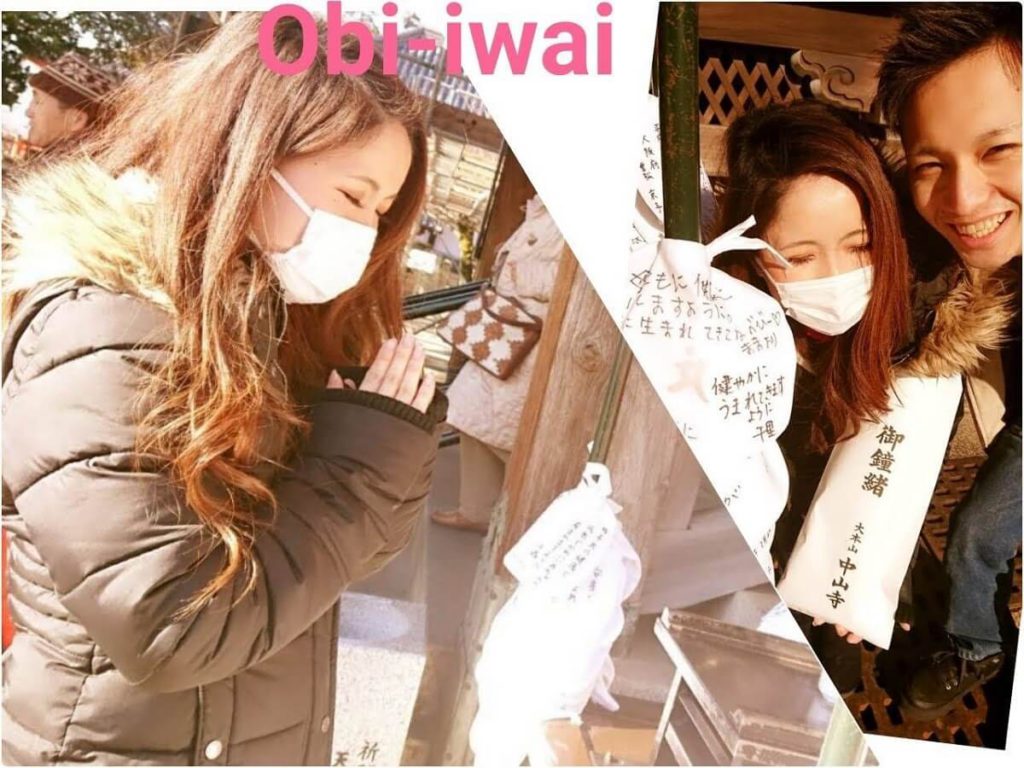
This is the first ceremony of the baby; it starts before the baby is born. This ceremony is held on Inu-no-hi (戌の日) when the expectant women become five months pregnant. “Inu-no-hi” means “Dog’s day.” What do you think of dogs? Cute, wise, and obedient. Well then, how is this related to birth? The answer is that we are hoping for an easy delivery and for having many babies at once. And it has been believed that praying for a baby and wearing a maternity belt called Hara obi (腹帯) in Inu-no-hi in the fifth month of pregnancy leads to an easy delivery. Who doesn’t pray for an easy and safe delivery of their child?
In addition, Dog’s day is the eleventh of the twelve-year cycle of animals in the Chinese calendar’s zodiac. And we also relate this day to this celebration.
Oshichi-ya(お七夜)
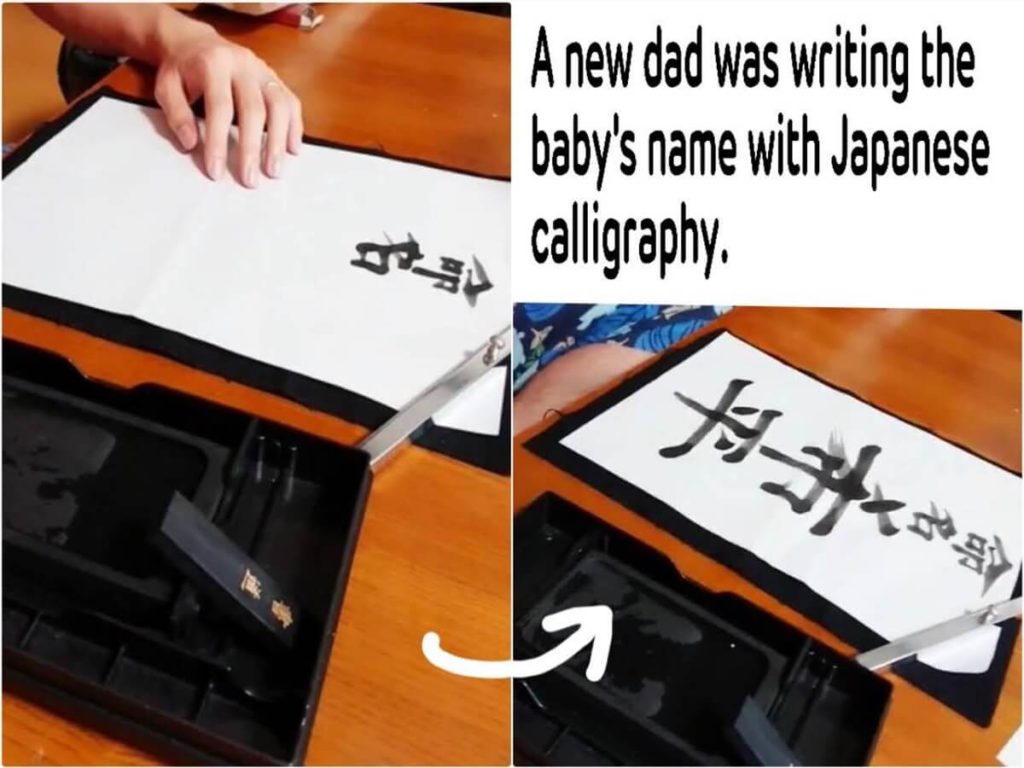
It’s a name-giving ceremony on the seventh day(“shichi,” 七, 7) after the baby’s birth. It takes place at night, which can be said as “ya” (夜) in Japanese. It is said that after getting their name, babies finally become a new member of the human community.
Omiyamairi(お宮参り)
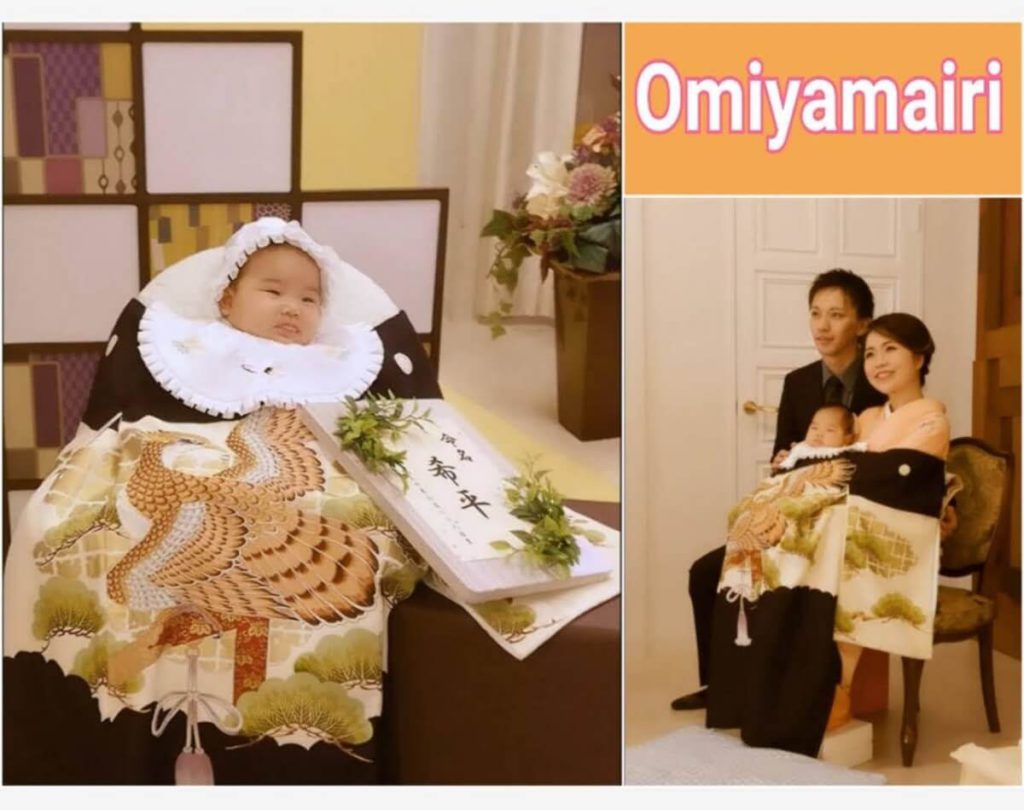
This is a very important event for the baby. When the baby is about a month old, their parents and their grandparents take their baby for its first visit to a shrine of the local guardian god, called the “Ujigami-sama” (氏神様). They tell the god about the new family member and pray for the baby’s happiness and good fortune. And also, if the baby is a boy, they write the character “大”, which means “big,” on his forehead. If the baby is a girl, they write the character “小” (“small”) on hers.
Okuizome(お食い初め)
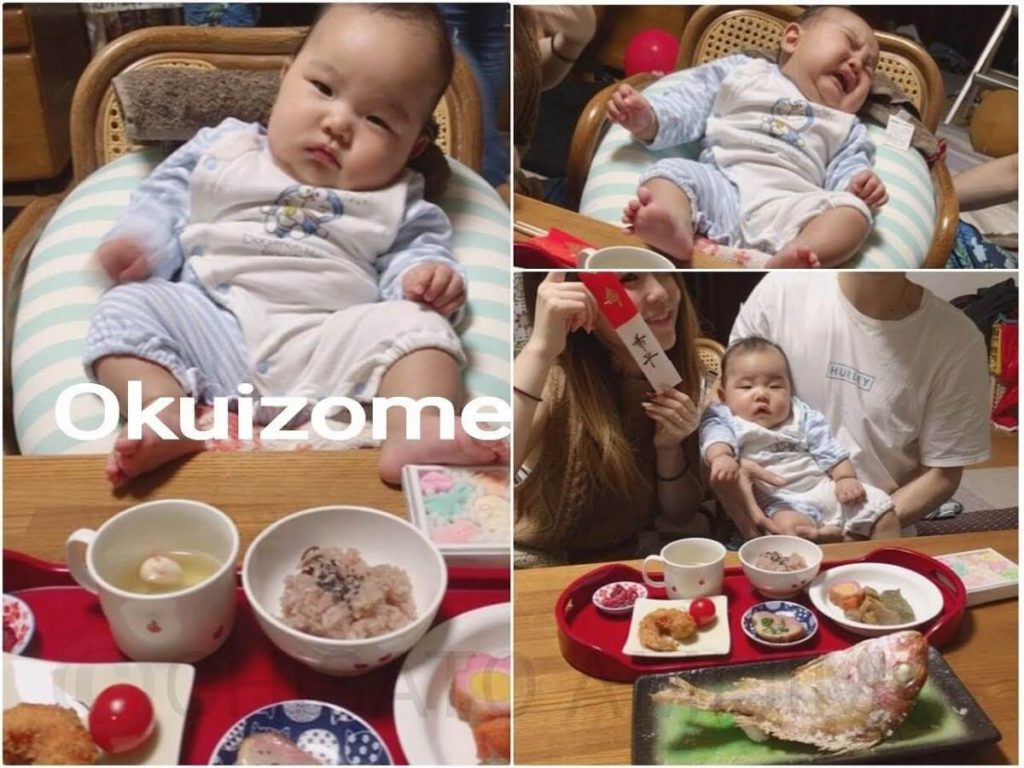
“Okuizome” (the first meal) is the traditional ceremony that parents perform around the 100th day after the baby’s birth along with their relatives and friends to wish that their baby will never starve in their own life by sharing a celebratory meal. The baby can’t eat anything yet, so they only pretend to feed the baby. In this ceremony, parents touch a stone that they found at a shrine with the chopsticks, and then they rub the tips of the chopsticks on the baby’s gums to wish for a healthy growth of teeth. That stone is called Ha-gatame-no-ishi (歯固めの石).
Shichi-go-san(七五三)

Shichi-go-san is a traditional Japanese ceremony celebrating the growth of children and wishing for continued good health that takes place on November 15th. Shichi-go-san (七五三) stands for the ages of seven, five and three. Girls celebrate when they are seven and three years old, and boys celebrate at three and five years old. Parents take their child to a shrine and the chief priest prays for each child’s good health and growth with them.
[Please live a long and healthy life.]
We pass by a lot of milestones while we go our own way in life, reaching adulthood, getting married, delivering, and so on. Then we gain extensive experience and get older and older.
Thus, we have celebrations of longevity in order to send our mothers, fathers, and grandparents gratitude and respect, and to wish more for their longevity.
In Japan, each ceremony of longevity has its own name and color.
And now, let’s change the story from the ceremony of a baby to a ceremony of longevity. Have you ever heard of these?
Kanreki (還暦) 60th birthday: RED
This ceremony originates in Juu-ni-jikkan: that the twelve Chinese zodiac signs and ten stems make a circuit once every 60 years. It symbolizes a person’s rebirth to a baby again and restarting their life. We use red because people believe red is a lucky color and babies are called “akachan” (赤ちゃん) “Aka” (赤) means “red” in Japanese.
Koki (古希) 70th birthday: PURPLE
This ceremony originates in a poem written by Toho, one of the most famous Chinese poets: “Threescore and ten is the age of men, and that rarely” (七十古来稀なり). In old times, people couldn’t live long lives. It’s so rare for a person to live until seventy years old. People celebrated their seventieth birthday by wishing for more yearsm safety, and health. . The purple has an effect of comforting the body and mind. And we wish they will live longer with eminence and regard from that image.
Kiju (喜寿) 77th birthday: PURPLE

This is a celebration of Japanese origin. The kanji letter “喜” written in Sousho calligraphy looks like “㐂,” which looks like “seventy seven.” Sousho is one of the brush strokes in Japanese calligraphy. It’s a style in which one character flows into another, like the wind blowing the grass.
Sanju (傘寿) 80th birthday: GOLD & YELLOW
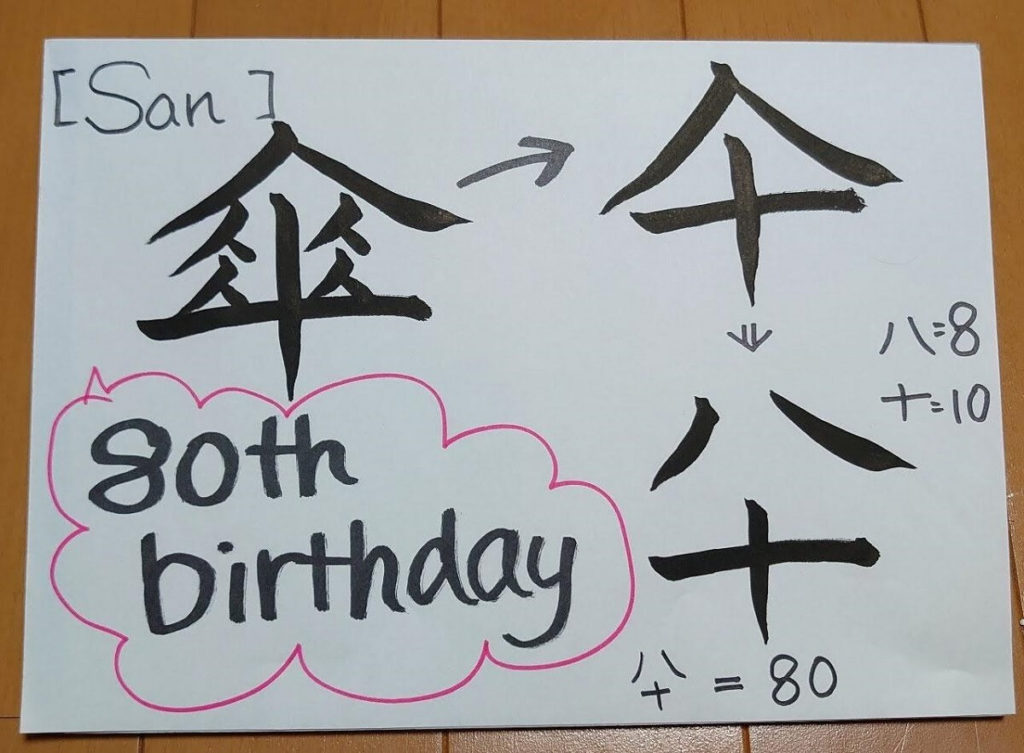
Kasa (傘) means “umbrella.” This celebration name originates from the abbreviated form of this kanji: 仐. It separates “仐” into pieces and looks like “八十,” which means “eighty.” This celebration color is gold and yellow, believed to bring good luck.
Beiju (米寿) 88th birthday: GOLD & YELLOW
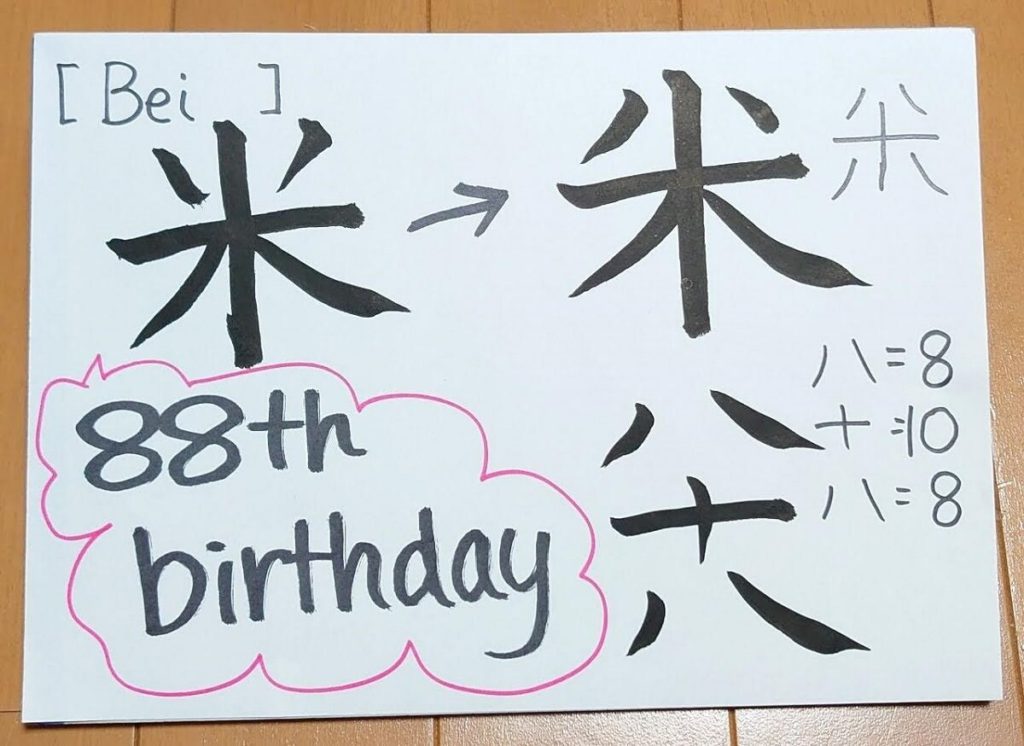
When you separate 米 (“Kome,” rice),then it looks like “八十八” (eighty-eight). So this celebration is named “Beiju” because we also call 米 can also be said as “bei.” The gold and yellow colors come from the appearance of rice in autumn.
Sotsuju (卒寿) 90th birthday: WHITE
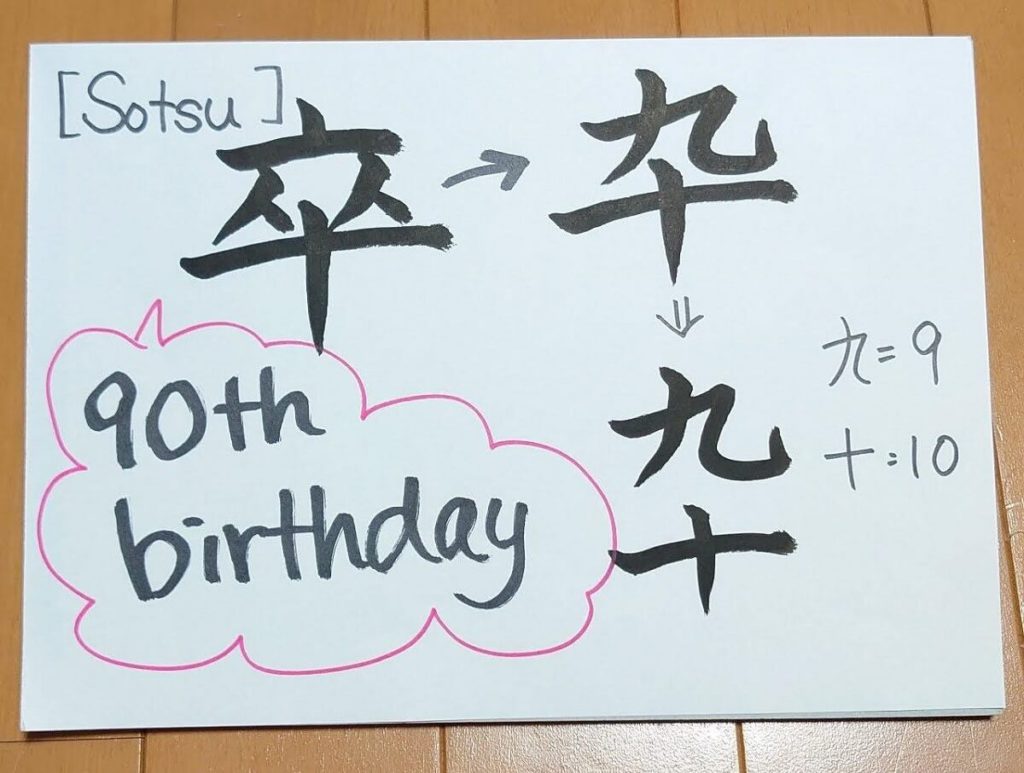
This celebration name originates from the abbreviated form of this kanji: 卒. We can read the abbreviated kanji “卆” as “九十,” or “ninety.”
Hakuju (白寿) 99th birthday: WHITE

If you subtract one from one hundred, you get ninety-nine, right? The kanji of “one hundred” is “百.” The kanji for “one” is “一.” The kanji for one hundred has a line on top that looks like the kanji for “one.”. If you remove the “一” line from the top of “百” (AKA subtract one from one hundred), the kanji that remains is “白,” or “white.” That’s why the 99th birthday’s name is 白寿 (“Hakuju,” “white” and “long life”).
Momoju (百寿) 100th birthday: WHITE & PINK
100 is usually pronounced as “hyaku,” but this time it’s pronounced “momo.” The 100th birthday celebration is Momoju. This one’s color is white and pink because it’s same pronunciation as Momo (桃), which means “peaches.” The color white represents innocence, holiness, and sacredness.
And there are three more celebrations: the 108th birthday celebration is Chaju (茶寿), the 111th one is Kouju (皇寿), and last one is the 120th birthday celebration, which is Dai-Kanreki (大還暦) .
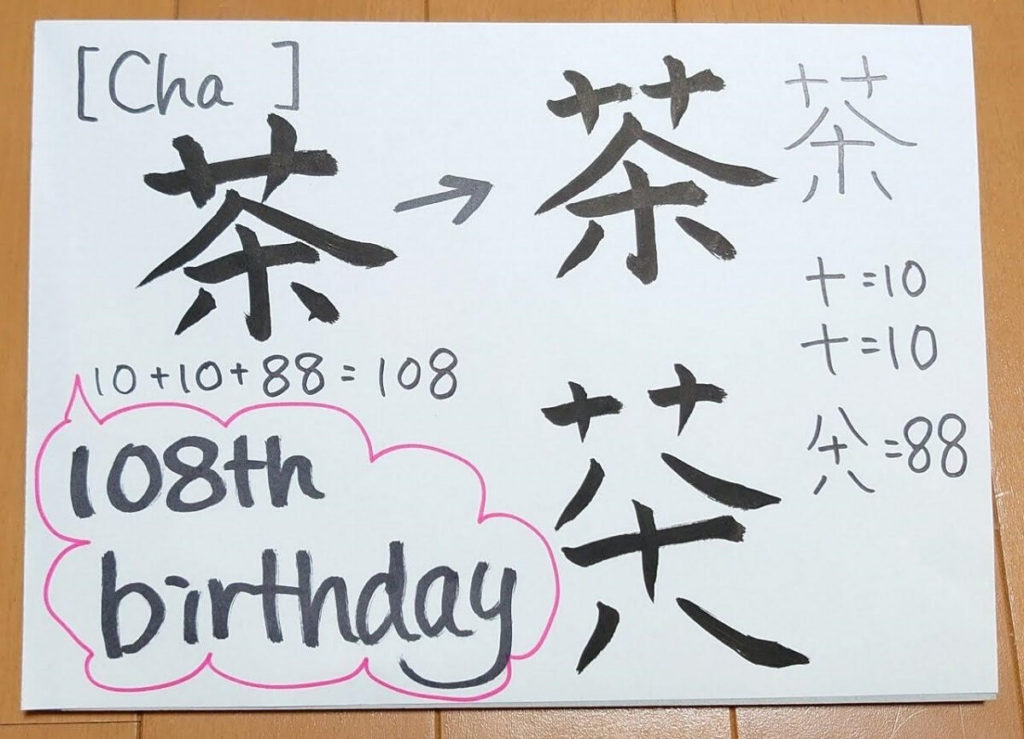

What did you think about Japanese celebrations of milestones? Were you also interested in the kanji structures?
By the way, there is a saying: “By the time you’d like to be a good son, your parents are already gone” and it’s a good one, isn’t it? Do you think about how many more times you can meet and talk with your parents? I would like to give back to my parents as much as possible with no regrets. Thanks to my parents, I am here. In my opinion, a longevity celebration is it’s the best opportunity to give back to our parents
We also appreciate the birth of the baby and pray for the baby’s safety and growth as I explained above.
We are grateful to our parents for giving birth to us and raising us, and we pray for their health and longevity. I really hope we can celebrate our family’s and friend’s celebrations together with a lot of warm hearts and gratitude.
Thank you.
I’m a clay artist, and a master of Japanese calligraphy “Onore-sho”. I have my own shop in Ikaruga town, Nara, which is near Horyuji temple: world heritage site. And I’m a volunteer English tour guide. I enjoy learning English everyday.


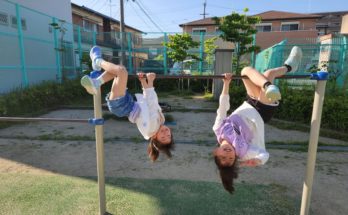
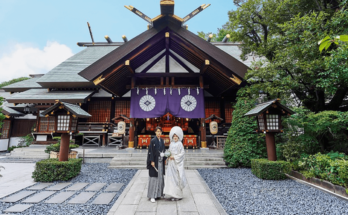
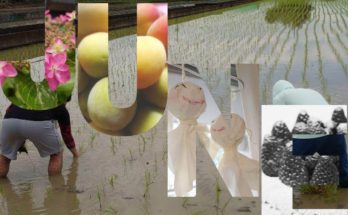
 HTJ has a YouTube page! Check it out
HTJ has a YouTube page! Check it out